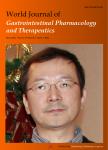Clinical and economic impact of infliximab one-hour infusion protocol in patients with inflammatory bowel diseases:A multicenter study
Clinical and economic impact of infliximab one-hour infusion protocol in patients with inflammatory bowel diseases:A multicenter study作者机构:Gastroenterology and Hepatology Section Dipartimento Biomedico di Medicina Interna e Specialistica University of Palermo IBD Unit Dipartimento di Medicina Interna e Terapia Medica University of Messina IBD and PelvicF loor Unit Azienda Ospedaliera per l’Emergenza Ospedale Cannizzaro Gastroenterology Section Casa Sollievo della Sofferenza S. Giovanni Rotondo Gastroenterology and Endoscopy Unit A.O.Bianchi-Melacrino-Morelli Fisiopatologia Digestiva Ospedale Spirito Santo Gastroenterology Section Gastroenterologia
出 版 物:《World Journal of Gastrointestinal Pharmacology and Therapeutics》 (世界胃肠药理与治疗学杂志(英文版)(电子版))
年 卷 期:2017年第8卷第2期
页 面:131-136页
学科分类:1002[医学-临床医学] 100201[医学-内科学(含:心血管病、血液病、呼吸系病、消化系病、内分泌与代谢病、肾病、风湿病、传染病)] 10[医学]
主 题:Infliximab One-hour infusion Cost savings Economic impact Multicenter study
摘 要:AIM To assess the impact of short infliximab(IFX) infusion on hospital resource utilization and *** All inflammatory bowel diseases(IBD) patients who received IFX 1 h infusion from March 2007 to September 2014 in eight centers from Southern Italy were included in the analysis. Demographic, clinical and infusion related data were collected. The potential benefits related to the short infusion protocol were assessed both in terms of time saving and increased infusion unit capacity. In addition, indirect patient-related cost savings were *** One hundred and twenty-five patients were recruited(64 with ulcerative colitis and 61 with Crohn s disease). Median duration of disease was of 53 mo and mean age of pts at diagnosis was of 34 years(SD: ± 13). Adverse infusion reactions were reported in less than 4% both before and after short infusion. The total number of infusions across the selected centers was of 2501(30.5% short infusions). In the analyzed cohort, 1143 h were saved(762 in the infusion and 381 in observation phases) through the rapid IFX infusion protocol. This time saving(-15% compared to the standard protocol in infusion phase) represents, from the hospital perspective, an opportunity to optimize infusion unit capacity by allocating the saved time in alternative cost-effective treatments. This is the case of opportunity cost that represents the value of forgone benefit which could be obtained from a resource in its next-best alternative use. Hence, an extra hour of infusion in the case of standard 2-h IFX represents a loss in opportunity to provide other cost effective services. The analysis showed that the short infusion increased the infusion units capacity up to 50% on days when the IFX infusions were scheduled(infusion phase). Furthermore, the analysis showed that the short IFX infusion protocol leads to time savings also in the post-infusion phase(observation) leading to a time saving of 10% on average among the analyzed centers. F



